Improving the Restorative Potential of Living Environments by Optimizing the Spatial Luminance Distribution
Abstract
1. Introduction
1.1. Research Background and Origin
1.2. Literature Review
1.2.1. Restorative Potential of Indoor Lighting Environments
1.2.2. Role of Visual Cognition in the Process of Environmental Restorative Perception
- Visual appeal
- 2.
- Visual load
1.2.3. Restorative Potential of Spatial Luminance Distribution
1.3. Research Overview
- (1)
- Obtaining a spatial luminance distribution pattern that can improve the restorative properties of the lighting environment while remaining suitable for different architectural configurations and disposition conditions;
- (2)
- Clarifying the role of spatial luminance distribution in improving environmental restoration. Specifically, the relationship between visual appeal and visual load caused by spatial luminance distribution in the process of restoration perception will be discussed as well as the influence path of spatial luminance distribution to improve the restorative potential (i.e., to improve visual attractiveness by increasing visual interest or to reduce visual load by changing the visual brightness);
- (3)
- Clarifying the connotation of restorative spatial luminance distribution (i.e., whether the visual cognitive conclusions of restorative spatial luminance distribution are the relationship between light and shadow or the layout relationship of lighting objects). On the basis of this conclusion, a construction strategy for restorative spatial luminance distribution is proposed.
2. Methods
- (1)
- The restorative potential of the lighting environment with different information-carrying conditions was evaluated using the Perceived Restorativeness Scale (PRS). To eliminate the influence of various information-carrying conditions, the natural light environment was set as the control.
- (2)
- Eye-movement indicators such as scanning, gaze behavior, and pupillary changes were measured using an eye tracker on the participants in the process of the perception restoration evaluation. The visual cognitive response data were extracted and the relationship between visual attraction and visual load caused by spatial luminance distribution was obtained.
- (3)
- Screening the typical lighting environment of Part 1 and using the comparison of cases and the focus group interview, the visual cognitive conclusions of spatial luminance distribution and the design optimization strategies of a restorative spatial luminance distribution pattern were explored.
2.1. Experimental Methods
2.1.1. Evaluation of Perceived Environmental Restorativeness
2.1.2. Eye-Movement Index Monitoring
2.1.3. Case Selection and Interview
2.2. Experimental Design
2.2.1. Selection of Indoor Spatial Environment
2.2.2. Spatial Luminance Measurement
2.2.3. Participants
2.2.4. Control Group
- L represents the restorativeness of the lighting environment; this is the average PRS score of a room under lighting environment.
- R represents the restorativeness of the indoor information-carrying conditions, which is the restorativeness of the indoor environment composed of intrinsic physical elements under a homogeneous luminance distribution pattern.
- N represents the restorativeness of the natural light environment, which we considered the restorative reserve level of environments. N represents the average PRS score of a room under natural lighting environment.
- W represents the restorativeness of the window view.
- P represents the change in environmental restorativeness under the influence of spatial luminance distribution (the value of P can be positive or negative).
2.2.5. Scenario Recurrence Method
2.2.6. Experimental Procedures
3. Results
3.1. Results of Perceived Restorativeness Evaluation
3.1.1. Average Score of the Perceived Restorativeness Scale
3.1.2. Difference between Scores of the Perceived Restorativeness Scale
- (1)
- N was between 1.84 and 2.51, D > 0 in most rooms, accounting for 73% (8/11);
- (2)
- N was between 2.53 and 3.23, D fluctuates, D > 0 in rooms, accounting for 38% (8/21);
- (3)
- N was between 3.43 and 4.21, D > 0 in rooms, accounting for 0% (0/11).
3.1.3. Change Ratio in the Scores of the Perceived Restorativeness Scale
3.2. Eye-Movement Indicator
3.2.1. Comparison of Eye-Movement Indicators
3.2.2. Analysis of the Fixation Duration Ratio of Different Material Information Carriers
3.2.3. Relationship between Perceived Restorativeness Evaluation and Eye-Movement Indicators
3.3. Results of Case Interview
3.3.1. Typical Cases (Groups)
- (1)
- The lighting environment with the highest and lowest L scores.
- (2)
- The lighting environment with the highest and lowest D/N
- When D/N was the highest, comparing N low with N medium (i.e., Figure 13a with Figure 13b), the luminance transition on the illuminated surfaces was also generally uniform and soft. The difference lay in the lighting method, but unlike the difference in the above-mentioned score, it is not a complete separation of linear and point sources, but mainly the involvement of point sources (N low has point sources, N medium does not). The overall feeling of the luminance of N medium was slightly brighter than that of N low.
- When N was medium, comparing the highest and lowest D/N (i.e., Figure 13b with Figure 13c), there was no significant difference in the overall feeling of luminance. In addition, similar to the difference in the above-mentioned score, the difference lay in the use of linear indirect lighting for high D/N, and point light sources for direct lighting for low D/N. Compared to the low D/N cases, high D/N cases had a more uniform and soft luminance transition on the illuminated surfaces.
- When D/N was the lowest, we compared the N medium with N high. Comparing Figure 13c with Figure 13d, the difference in the lighting method was not significant. This comparison seems to indicate that there is no significant correlation between the lowest D/N and spatial luminance distribution. Analyzing the natural light environment, as shown in Figure 14, most of these rooms had large windows with particularly open views, and the natural landscape in the window view accounted for a large proportion of the view. Therefore, the reduction in restorativeness was mainly due to the lack of window view restoration rather than the spatial luminance distribution.
3.3.2. Conclusions on the Visual Perception of Spatial Luminance Distribution
3.3.3. Cognitive Characteristics of Restorative Spatial Luminance Distribution
- (1)
- Restorative Spatial Luminance Distribution Case Study
- (2)
- Cognitive Characteristics of Restorative Spatial Luminance Distribution
4. Discussion
4.1. Discussion of Results
4.1.1. Discussion of the Results of the Perceived Restorativeness Evaluation
4.1.2. Discussion of the Results of the Eye-Movement Indicator
4.1.3. Discussion of the Results of the Case Interviews
4.2. Optimization Strategies for Spatial Luminance Distribution in Environments with Different Restorative Reserve Levels, Guided by Environmental Restorativeness Improvement Goals
4.3. Implications and Limitations
- Limitations of eye tracking: As above-mentioned, the division of AOIs does not specifically consider the boundaries of highlights. Determining the boundaries of uniformly transitioning highlights is a problem that needs to be addressed in future research. Our current eye-movement measurements were performed in scenarios where the participants had no explicit visual task. For a comparison with previous studies [53], further research is needed for scenarios with explicitly focused visual tasks, which is a focus for future attention.
- Limitations of the survey: (1) Although the survey ensured the comprehensiveness of the decoration level, currently, hotel rooms tend to have a simple and concise style, which is the mainstream trend from the perspective of saving on costs and space. However, whether the corresponding research conclusions apply to other living environments that are more complex and have a heavier visual load needs to be further validated in future research. (2) Although there was consistency in the layout of the surveyed rooms, the differences in the architectural configuration and disposition of the space and the spatial scale resulted in different classes of environmental restorative reserve levels. This study focused on the impact of window views and the material information-carrying properties of light (decoration basis) on the environmental restorative reserve level, but did not establish a clear causal relationship; at the same time, this study ignored the influence of factors such as spatial size and seasonal time, which are areas of research that should be supplemented and developed with the subsequent construction of a full-size laboratory.
- Limitations on the findings of the “luminance distribution” study: The focus of this study was to prove that the restorative potential of the residential environment could be improved by optimizing the spatial luminance distribution, and the research conclusions proved our hypothesis. Our study of the spatial luminance distribution was based on images within a limited range of luminance levels in the room environment and at the display’s set luminance. Therefore, validation from a broader range of empirical research is needed. Although we conducted a comprehensive collection of the spatial luminance parameter data, these data need to be made available for quantitative characterization of the distribution features. Therefore, a restorative spatial luminance distribution index was not proposed in this study, and will be the focus of our attention in a subsequent study.
5. Conclusions
- (1)
- The spatial luminance distribution of lighting had a considerable improvement rate of 30.9% for environmental restorativeness. However, at the same time, there was an equal reduction ratio. The spatial luminance distribution of lighting improved the restorative perception potential, which was negatively correlated with the restorative reserve level of the environment (the correlation coefficient values were −0.405, p < 0.01). Resilient spatial luminance distribution patterns suitable for different restorative reserve levels are recommended as follows: for high-level restorativeness, a homogeneous pattern should be provided; for medium-level restorativeness, the best optimization and improvement should be achieved by considering rationality and by utilizing and exploring patterns; for low-level restorativeness, a restorative pattern should be created whereby the spatial luminance distribution of lighting itself becomes a restorative environmental element.
- (2)
- The eye-movement data findings clarify the role of visual perception in improving environmental restorativeness with spatial luminance distribution (i.e., restorative perception is positively correlated with visual appeal and negatively correlated with visual load). Visual appeal and visual load have an opposing yet coexisting relationship.
- (3)
- The visual cognitive conclusions of spatial luminance distribution included six dimensions: light source, highlights, bright objects, visible objects, dim objects, and shadow. Common characteristics of restorative spatial luminance distribution include a single highlight with uniform light and no stray light transition, a consistent highlight shape within the group and ordered highlight sequence between groups, and the appropriate illumination effect of a single bright object.
- (4)
- Based on the above conclusions, this paper developed a hierarchical classification according to the restorative reserve level, and clarified the optimization goals of visual appeal and visual load for environments with different restorative reserve levels. We also established initial optimization approaches and applicable spatial luminance distribution configurations under the optimization goals. The characteristics of the obtained restorative spatial luminance distribution pattern focused on the luminance hierarchy gradients and luminance contrast spans, which also describe the optimization strategy of restorative environmental lighting design.
Author Contributions
Funding
Data Availability Statement
Acknowledgments
Conflicts of Interest
References
- Engineer, A.; Gualano, R.J.; Crocker, R.L.; Smith, J.L.; Maizes, V.; Weil, A.; Sternberg, E.M. An integrative health framework for wellbeing in the built environment. Build. Environ. 2021, 205, 108253. [Google Scholar] [CrossRef]
- Gellatly, R.; Beck, A.T. Thrive: The Power of Evidence-Based Psychological Therapies. J. Psychiatr. Pract. 2014, 20, 412–413. [Google Scholar] [CrossRef]
- Woolston, C.; O’Meara, S. PhD students in China report misery and hope. Nature 2019, 575, 711–713. [Google Scholar] [CrossRef] [PubMed]
- Kaplan, S. A Model of Person-Environment Compatibility. Environ. Behav. 1983, 15, 311–332. [Google Scholar] [CrossRef]
- Ottosson, J.; Grahn, P. A Comparison of Leisure Time Spent in a Garden with Leisure Time Spent Indoors: On Measures of Restoration in Residents in Geriatric Care. Landsc. Res. 2005, 30, 23–55. [Google Scholar] [CrossRef]
- Lohr, V.I.; Pearson-Mims, C.H.; Goodwin, G.K. Interior Plants May Improve Worker Productivity and Reduce Stress in a Windowless Environment. J. Environ. Hortic. 1996, 14, 97–100. [Google Scholar] [CrossRef]
- Ulrich, R.S. View Through a Window May Influence Recovery from Surgery. Science 1984, 224, 420–421. [Google Scholar] [CrossRef]
- Xiao, L.; Wu, R.; Huang, J.; Yang, X.; Xu, A. Study on the Relationship between Restoration Benefit and Visual Satisfaction of LONG-PLAN’s Indoor Vertical Greenery. Buildings 2022, 12, 1267. [Google Scholar] [CrossRef]
- Wang, Y.T. Restoration Benefits Research on Bedrooms of Holiday Cabins. Master’s Thesis, Harbin Institute of Technology, Harbin, China, 2018. [Google Scholar]
- Ouellette, P.; Kaplan, R.; Kaplan, S. The monastery as a restorative environment. J. Environ. Psychol. 2005, 25, 175–188. [Google Scholar] [CrossRef]
- Kaplan, S.; Bardwell, L.V.; Slakter, D.B. The Museum as a Restorative Environment. Environ. Behav. 1993, 25, 725–742. [Google Scholar] [CrossRef]
- Twedt, E.; Rainey, R.M.; Proffitt, D.R. Beyond nature: The roles of visual appeal and individual differences in perceived restorative potential. J. Environ. Psychol. 2019, 65, 101322. [Google Scholar] [CrossRef]
- Hawkes, R.J.; Loe, D.L.; Rowlands, E. A Note towards the Understanding of Lighting Quality. J. Illum. Eng. Soc. 1979, 8, 111–120. [Google Scholar] [CrossRef]
- Loe, L.; Mansfield, K.P.; Rowlands, E. Appearance of lit environment and its relevance in lighting design: Experimental study. Int. J. Light. Res. Technol. 1994, 26, 119–133. [Google Scholar] [CrossRef]
- Chen, T.; Wang, L.; Li, Y.; Chen, P.; Yu, J. Modeling perceptions of very small space in physical dimension: Effect of the form of line light-emitting units with preference. Build. Environ. 2023, 228, 109803. [Google Scholar] [CrossRef]
- Cuttle, C. Extending the lighting design objectives procedure for holistic lighting solutions. Light. Res. Technol. 2022, 54, 631–656. [Google Scholar] [CrossRef]
- Leccese, F.; Salvadori, G.; Rocca, M.; Buratti, C.; Belloni, E. A method to assess lighting quality in educational rooms using analytic hierarchy process. Build. Environ. 2020, 168, 106501. [Google Scholar] [CrossRef]
- Kong, Z.; Jakubiec, J.A. Instantaneous lighting quality within higher educational classrooms in Singapore. Front. Archit. Res. 2021, 10, 787–802. [Google Scholar] [CrossRef]
- Dang, R.; Liu, Y.; Chang, S. The impact patterns of classroom lighting parameters on visual fatigue and a mathematical model. Build. Environ. 2023, 234. [Google Scholar] [CrossRef]
- Leccese, F.; Salvadori, G.; Montagnani, C.; Ciconi, A.; Rocca, M. Lighting assessment of ergonomic workstation for radio diagnostic reporting. Int. J. Ind. Ergon. 2017, 57, 42–54. [Google Scholar] [CrossRef]
- Aries MB, C.; Veitch, J.A.; Newsham, G.R. Windows, view, and office characteristics predict physical and psychological discomfort. J Environ Psychol. 2010, 30, 533–541. [Google Scholar] [CrossRef]
- Rutten, S.; Vriend, C.; Smit, J.H.; Berendse, H.W.; Van Someren, E.J.; Hoogendoorn, A.W.; Twisk, J.W.; Van Der Werf, Y.D.; Van Den Heuvel, O.A. Bright light therapy for depression in Parkinson disease. Neurology 2019, 92, e1145. [Google Scholar] [CrossRef] [PubMed]
- Tantanatewin, W.; Inkarojrit, V. Effects of color and lighting on retail impression and identity. J. Environ. Psychol. 2016, 46, 197–205. [Google Scholar] [CrossRef]
- Schielke, T.; Leudesdorff, M. Impact of lighting design on brand image for fashion retail stores. Light. Res. Technol. 2015, 47, 672–692. [Google Scholar] [CrossRef]
- Wessolowski, N.; Koenig, H.; Schulte-Markwort, M.; Barkmann, C. The effect of variable light on the fidgetiness and social behavior of pupils in school. J. Environ. Psychol. 2014, 39, 101–108. [Google Scholar] [CrossRef]
- Nikunen, H.J.; Korpela, K.M. Restorative Lighting Environments-Does the Focus of Light Have an Effect on Restorative Experiences? J. Light Vis. Environ. 2009, 33, 37–45. [Google Scholar] [CrossRef]
- Nikunen, H.; Puolakka, M.; Rantakallio, A.; Korpela, K.; Halonen, L. Perceived restorativeness and walkway lighting in near-home environments. Light. Res. Technol. 2013, 46, 308–328. [Google Scholar] [CrossRef]
- Tregenza, P.; Mardaljevic, J. Daylighting buildings: Standards and the needs of the designer. Light. Res. Technol. 2018, 50, 63–79. [Google Scholar] [CrossRef]
- Bowler, D.E.; Buyung-Ali, L.M.; Knight, T.M.; Pullin, A.S. A systematic review of evidence for the added benefits to health of exposure to natural environments. BMC Public Health 2010, 10, 456. [Google Scholar] [CrossRef]
- Thompson Coon, J.; Boddy, K.; Stein, K.; Whear, R.; Barton, J.; Depledge, M.H. Does participating in physical activity in outdoor natural environments have a greater effect on physical and mental wellbeing than physical activity indoors? A systematic review. Environ. Sci. Technol. 2011, 45, 1761–1772. [Google Scholar] [CrossRef]
- Stevenson, M.P.; Dewhurst, R.; Schilhab, T.; Bentsen, P. Cognitive Restoration in Children following Exposure to Nature: Evidence from the Attention Network Task and Mobile Eye Tracking. Front. Psychol. 2019, 10, 42. [Google Scholar] [CrossRef]
- Joye, Y.; van den Berg, A. Is love for green in our genes? A critical analysis of evolutionary assumptions in restorative environments research. Urban For. Urban Green. 2011, 10, 261–268. [Google Scholar] [CrossRef]
- Franěk, M.; Šefara, D.; Petružálek, J.; Cabal, J.; Myška, K. Differences in eye movements while viewing images with various levels of restorativeness. J. Environ. Psychol. 2018, 57, 10–16. [Google Scholar] [CrossRef]
- Russell, S. The Architecture of Light, 2nd ed.; Conceptnine: La Jolla, CA, USA, 2012; pp. 13–97. [Google Scholar]
- Cuttle, C. Towards the third stage of the lighting profession. Light. Res. Technol. 2009, 42, 73–93. [Google Scholar] [CrossRef]
- Oi, N.; Mansfield, K.P. Lighting quality: Possibility of luminance distribution as its determinant. In Proceedings of the 28th Session of the CIE, Manchester, UK, 28 June–4 July 2015. [Google Scholar]
- Liu, W. Research on Intelligent Control of Residential Artificial Lighting Light Environment. Ph.D. Thesis, Chongqing University, Chongqing, China, 2003. [Google Scholar]
- Hamilton, D.K.; Watkins, D.H. Evidence-Based Design for Multiple Building Types; Wiley: Hoboken, NJ, USA, 2009; p. 255. [Google Scholar]
- Wang, T.-C.; Tsai, C.-L.; Tang, T.-W. Restorative quality in tourist hotel marketing pictures: Natural and built characteristics. Curr. Issues Tour. 2019, 22, 1679–1685. [Google Scholar] [CrossRef]
- Asberg Johnels, J.; Gillberg, C.; Falck-Ytter, T.; Miniscalco, C. Face-viewing patterns in young children with autism spectrum disorders: Speaking up for the role of language comprehension. J. Speech Lang. Hear. Res. 2014, 57, 2246–2252. [Google Scholar] [CrossRef]
- Liu, Y.; Hu, M.; Zhao, B. Audio-visual interactive evaluation of the forest landscape based on eye-tracking experiments. Urban For. Urban Green. 2019, 46, 126476. [Google Scholar] [CrossRef]
- Zhao, N.; Reinhart, C.F.; Paradiso, J.A. Image-based perceptual analysis of lit environments. Light. Res. Technol. 2018, 51, 704–724. [Google Scholar] [CrossRef]
- Raynham, P. Room lighting in the absence of a defined visual task and the impact of mean room surface exitance. Light. Res. Technol. 2014, 48, 190–204. [Google Scholar] [CrossRef]
- Flynn, J.; Spencer, T.; Martyniuk, O.; Hendrick, C. Interim Study of Procedures for Investigating the Effect of Light on Impression and Behavior. J. Illum. Eng. Soc. 2013, 3, 87–94. [Google Scholar] [CrossRef]
- Hartig, T.; Korpela, K.; Evans, G.W.; Gärling, T. A measure of restorative quality in environments. Scand. Hous. Plan. Res. 1997, 14, 175–194. [Google Scholar] [CrossRef]
- Chen, P.; Wang, A.; Wang, L.; Wu, Y.; Yu, J. Grayscale−luminance converting polynomial function for digital images to determine Feu and Lav in a low-contrast artificial lit space. Light. Res. Technol. 2022, 55, 258–280. [Google Scholar] [CrossRef]
- Uttley, J. Power Analysis, Sample Size, and Assessment of Statistical Assumptions—Improving the Evidential Value of Lighting Research. Leukos 2019, 15, 143–162. [Google Scholar] [CrossRef]
- Staats, H.; Kieviet, A.; Hartig, T. Where to recover from attentional fatigue: An expectancy-value analysis of environmental preference. J. Environ. Psychol. 2003, 23, 147–157. [Google Scholar] [CrossRef]
- Strauss, A.; Corbin, J. Basics of Qualitative Research, 4th ed.; Sage Publications: London, UK, 1998. [Google Scholar]
- Waldram, J.M. Studies in Interior Lighting. Trans. Illum. Eng. Soc. 1954, 19, 95–133. [Google Scholar] [CrossRef]
- Wataru, I.; Masayuki, I. New lighting evaluation techniques for comfortable lighting spaces using sensation-of-room-brightness index “Feu”. Matsushita Tech. J. 2008, 53, 132–134. [Google Scholar]
- Yamaguchi, H.; Shinoda, H. Space Brightness Evaluated Using Border Luminance of Color Appearance Mode. J. Illum. Eng. Inst. Jpn. 2007, 91, 266–271. [Google Scholar] [CrossRef]
- Holmqvist, K.; Örbom, S.L.; Hooge, I.T.; Niehorster, D.C.; Alexander, R.G.; Andersson, R.; Benjamins, J.S.; Blignaut, P.; Brouwer, A.M.; Chuang, L.L.; et al. Eye tracking: Empirical foundations for a minimal reporting guideline. Behav. Res. Methods 2023, 55, 364–416. [Google Scholar] [CrossRef]
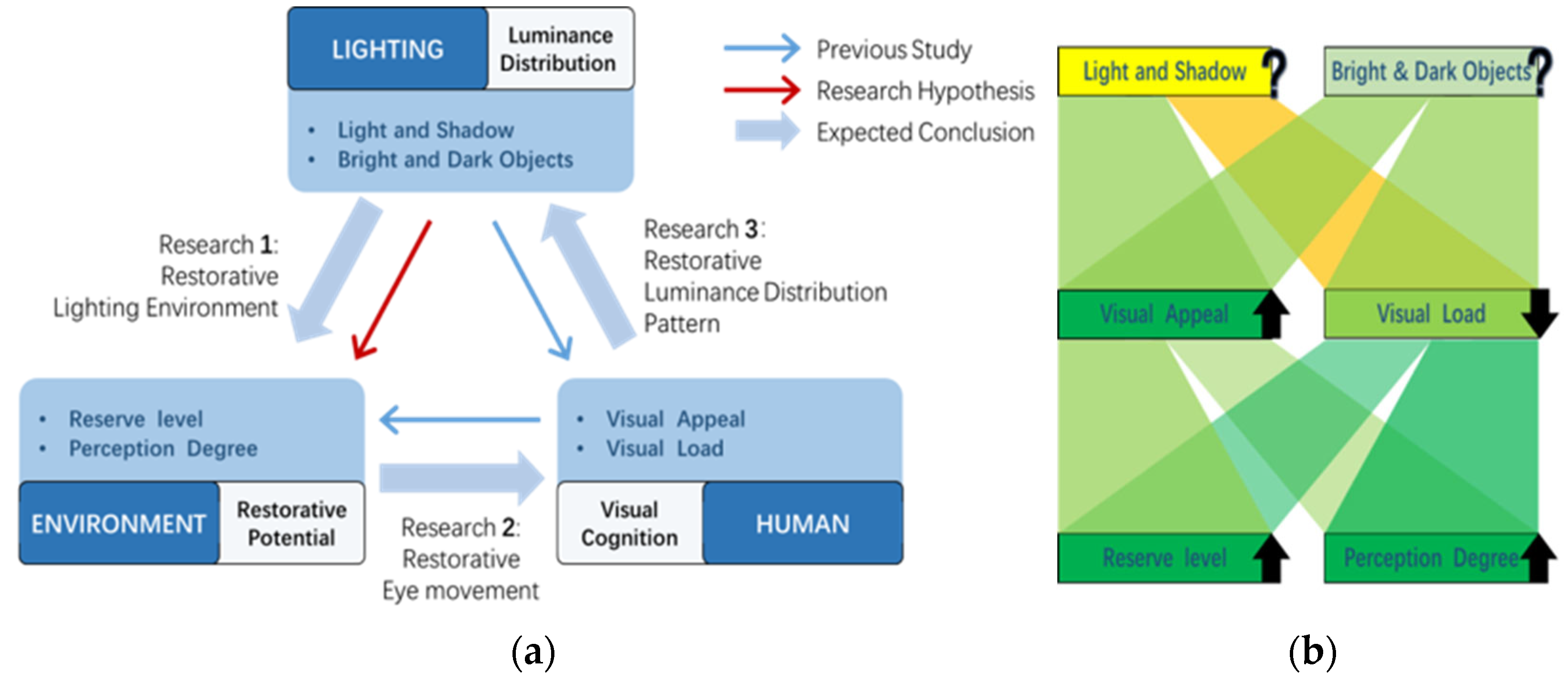
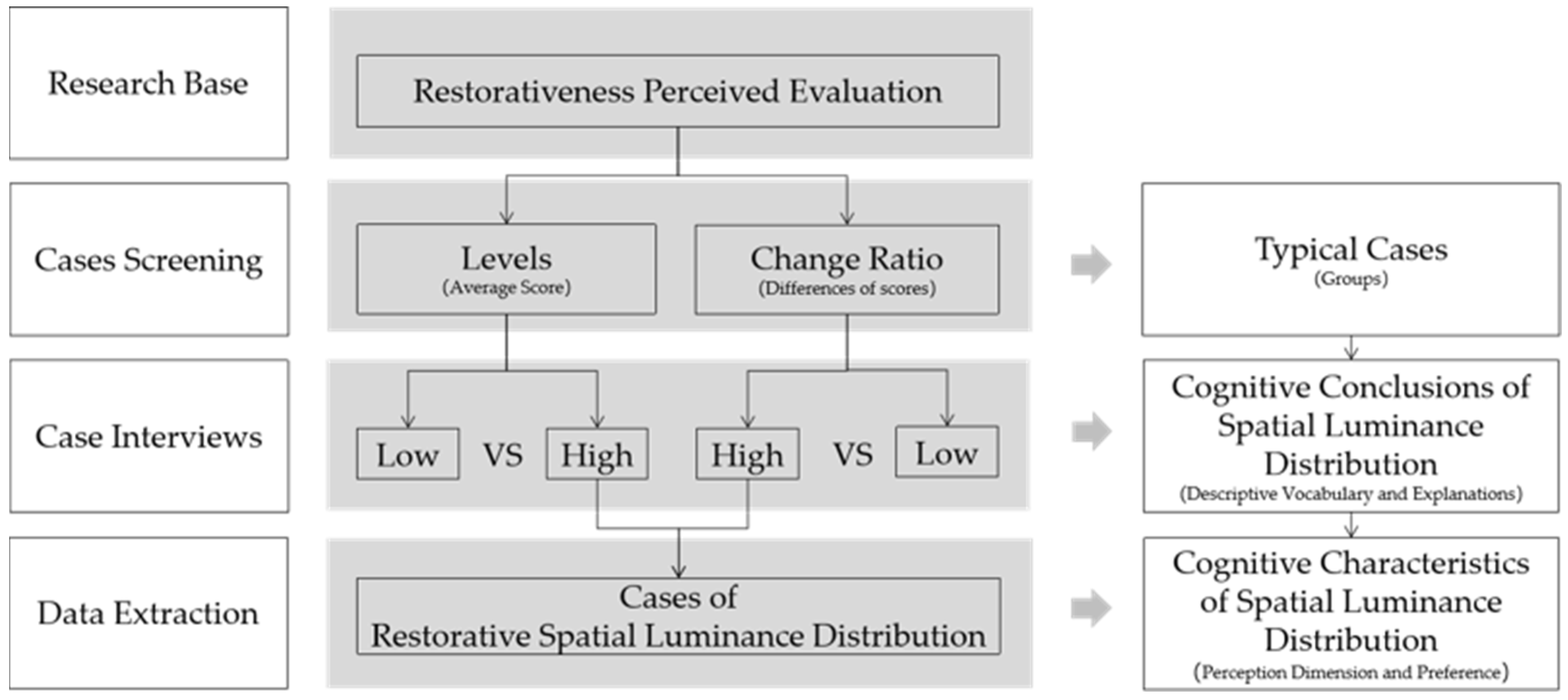
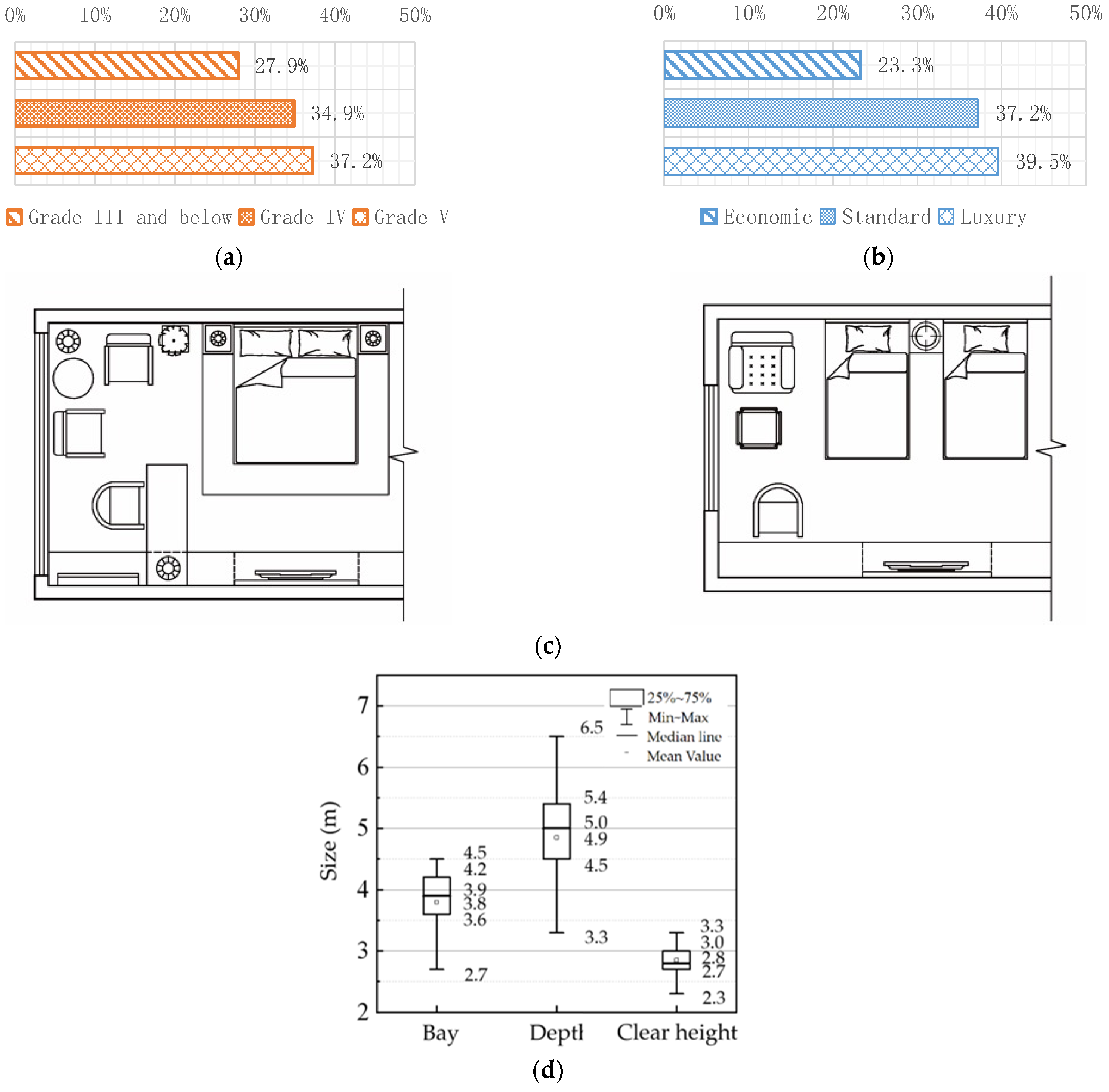
 —ceiling; BXX with
—ceiling; BXX with  —sidewall at the bedhead; WXX with
—sidewall at the bedhead; WXX with  —window side wall; TXX with
—window side wall; TXX with  —sidewall beside TV; DXX with
—sidewall beside TV; DXX with  —floor; PXX with
—floor; PXX with  —decoration; FXX with
—decoration; FXX with  —furniture.
—furniture.
 —ceiling; BXX with
—ceiling; BXX with  —sidewall at the bedhead; WXX with
—sidewall at the bedhead; WXX with  —window side wall; TXX with
—window side wall; TXX with  —sidewall beside TV; DXX with
—sidewall beside TV; DXX with  —floor; PXX with
—floor; PXX with  —decoration; FXX with
—decoration; FXX with  —furniture.
—furniture.
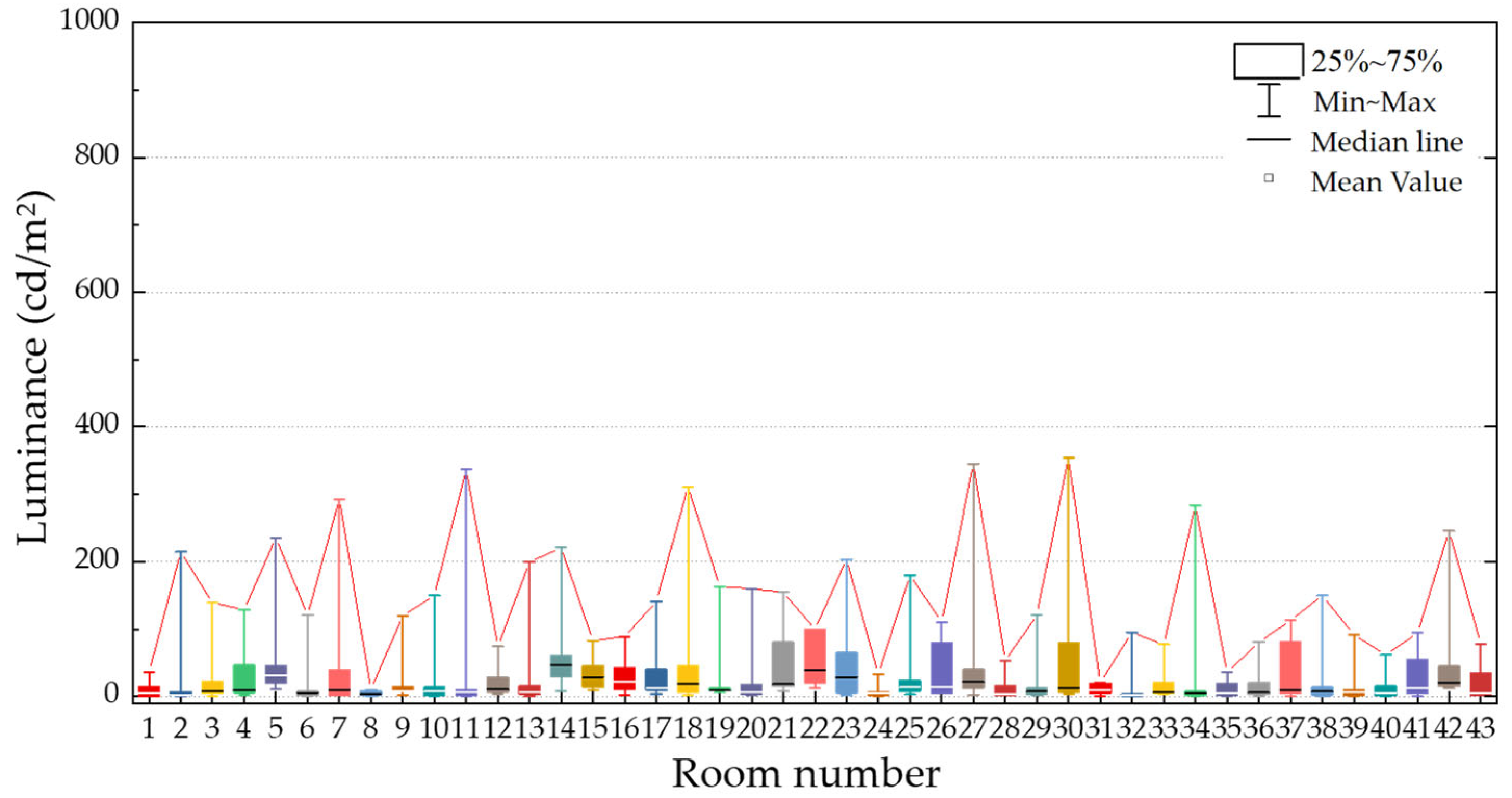




 represents N between 1.84 and 2.51.
represents N between 1.84 and 2.51.  represents N between 2.53 and 3.23.
represents N between 2.53 and 3.23.  represents N between 3.43 and 4.21.
represents N between 3.43 and 4.21.
 represents N between 1.84 and 2.51.
represents N between 1.84 and 2.51.  represents N between 2.53 and 3.23.
represents N between 2.53 and 3.23.  represents N between 3.43 and 4.21.
represents N between 3.43 and 4.21.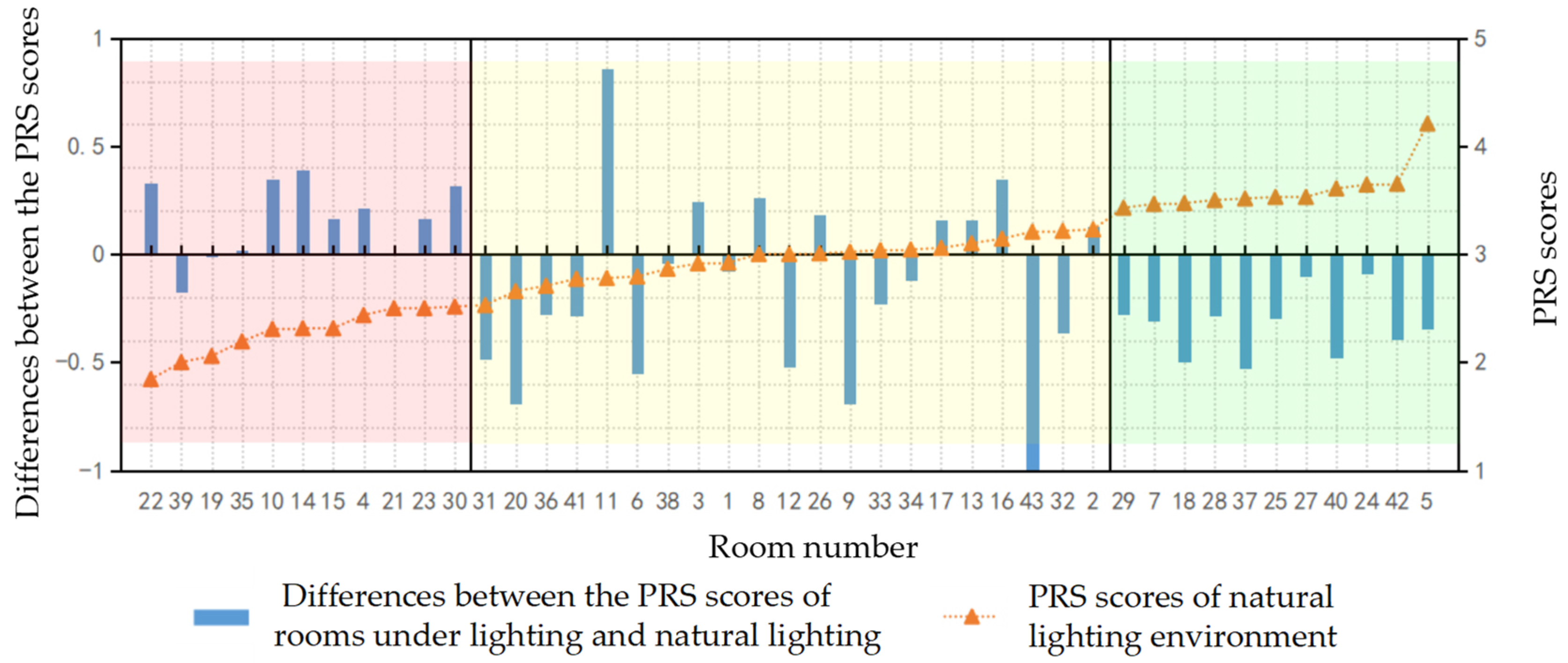

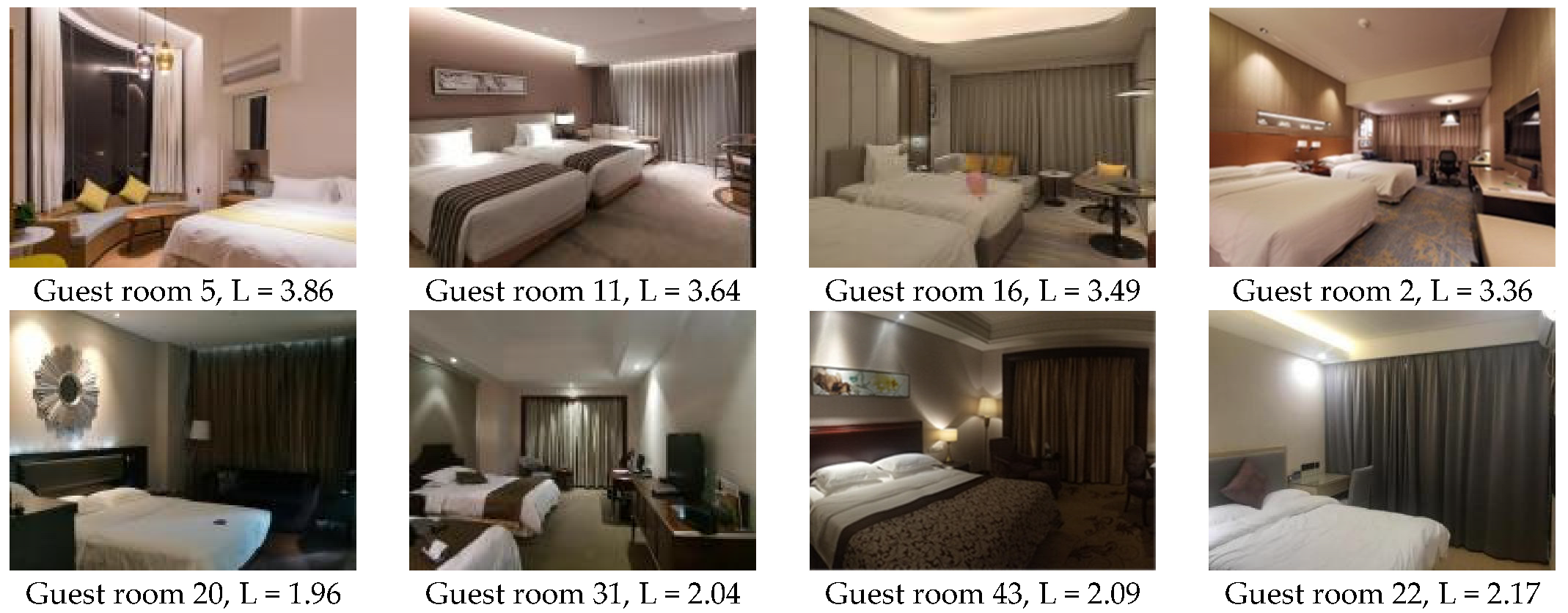
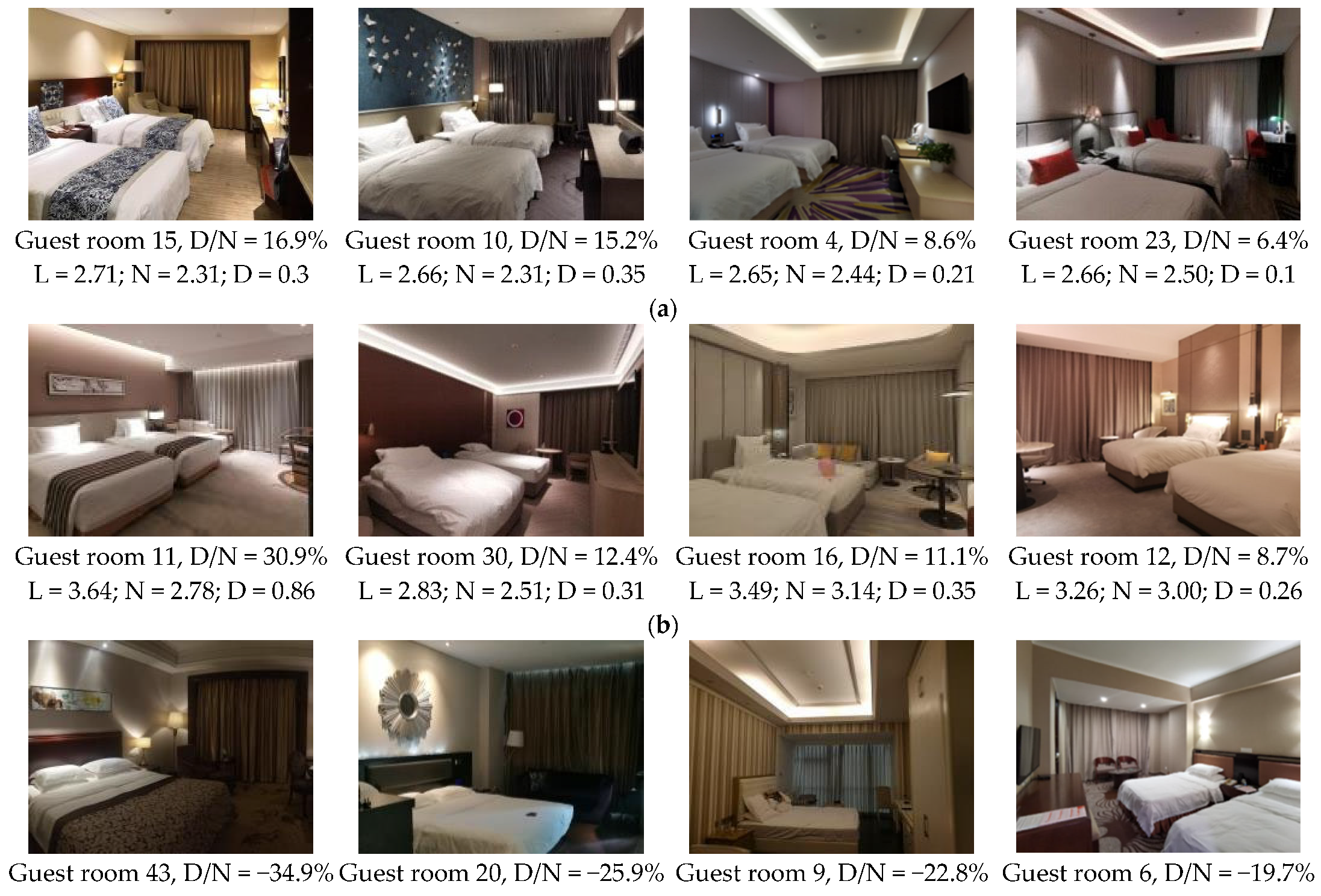



| No. | Questions and Explanation |
|---|---|
| 1 | Q1: This room makes it easy for you to relax and stay away from daily pressures and worries. |
| Explanation: Leaving a stressful and tense environment to avoid psychological fatigue and allow attention to recover. | |
| 2 | Q2: This room is charming and interesting, which makes you want to know more about it. |
| Explanation: The environment is attractive enough, and there is no need for extra effort to improve attention, thus allowing attention to recover. | |
| 3 | Q3: This room makes you feel comfortable and can do what you like. |
| Explanation: The content of the environment fills in one’s visual field and mind, allowing concentrated attention to rest. | |
| 4 | Q4: This is a room suitable for your rest. |
| Explanation: The environment provides a good fit with one’s purposes or inclinations |
| No. | Type | Eye-Movement Indicators | Definition |
|---|---|---|---|
| 1 | Saccade | Saccade count (SC) | Search process |
| 2 | Total saccading time (ST) | Cognitive processing difficulty of the overall environment | |
| 3 | Fixation | Fixation count (FC) | Distribution of visual attention |
| 4 | Total fixation time (TFT) | Overall attractiveness of the environment | |
| 5 | Average fixation time (AFT) | Attractiveness of the target (point of interest) | |
| 6 | Fixation duration ratio of AOI (FDR) | Attractiveness of areas of interest | |
| 7 | Pupil change | Average pupil diameter (APD) | Visual cognitive load of participants |
| No. | AOI | Map of the Exhibition |
|---|---|---|
| 1 | Ceiling |  |
| 2 | Floor | |
| 3 | Sidewall beside TV | |
| 4 | Sidewall at bedhead | |
| 5 | Window side wall | |
| 6 | Furniture | |
| 7 | Decoration | |
| 8 | Luminaire | |
| 9 | Greenery |
| No. | Interviewees | Questions |
|---|---|---|
| 1 | Single case | Please describe the characteristics of the lighting environment according to its luminance distribution. |
| 2 | Cases in the same group | Please describe the common characteristics of the lighting environment in this group according to the luminance distribution. |
| 3 | Control | Please describe the difference of the characteristics of these two groups of lighting environments according to the luminance distribution. |
| Group | Environmental Conditions | Commonality | Difference | |
|---|---|---|---|---|
| Spatial Luminance Distribution | Window View | |||
| Control | Natural lighting | Carrier (interface, decoration, parts, and other indoor physical elements) | Uniform luminance distribution pattern | Natural outdoor view |
| Experimental | Lighting | Lighting luminance distribution pattern | Covered by curtain, no outdoor view | |
| Eye-Movement Indicators | Lighting | Natural Lighting | t | p | |
|---|---|---|---|---|---|
| Mean ± SE | Mean ± SE | ||||
| Saccade | Saccade count | 300.546 ± 3.605 ↑ | 294.707 ± 4.033 | −1.129 | 0.172 |
| Total saccade time | 13.255 ± 0.188 ↑ | 12.896 ± 0.211 | −1.301 | 0.201 | |
| Fixation | Fixation count | 107.389 ± 1.681 ↓ | 110.483 ± 1.877 | 1.365 | 0.179 |
| Total fixation time | 21.871 ± 0.499 ↓ | 23.290 ± 0.579 | 2.043 | 0.047 * | |
| Average fixation time | 0.206 ± 0.002 ↓ | 0.214 ± 0.002 | 2.687 | 0.010 * | |
| Pupil | Mean pupil diameter | 3.774 ± 0.029 ↑ | 3.630 ± 0.20 | −3.792 | 0.000 ** |
| AOI | Lighting | Natural Lighting | t | p | Cohen’s d | D-Value | Change Ratio |
|---|---|---|---|---|---|---|---|
| Mean ± SE | Mean ± SE | ||||||
| 1 Ceiling | 4.408 ± 0.488 | 2.192 ± 0.241 | −4.819 | 0.000 ** | 0.735 | 2.216 | 101.1% |
| 2 Floor | 7.369 ± 0.648 | 9.127 ± 0.841 | 3.439 | 0.001 ** | 0.524 | −1.758 | −19.3% |
| 3 Sidewall beside TV | 4.758 ± 0.866 | 4.510 ± 0.868 | −0.503 | 0.618 | 0.077 | 0.248 | 5.5% |
| 4 Sidewall at bedhead | 19.141 ± 1.664 | 12.288 ± 1.417 | −6.093 | 0.000 ** | 0.929 | 6.853 | 55.8% |
| 5 Window side wall | 24.407 ± 1.242 | 29.628 ± 1.471 | 4.272 | 0.000 ** | 0.652 | −5.221 | −17.6% |
| 6 Furniture | 44.660 ± 1.653 | 42.195 ± 1.648 | −2.114 | 0.041 * | 0.322 | 2.465 | 5.8% |
| 7 Decoration | 4.959 ± 0.918 | 3.852 ± 0.853 | −2.028 | 0.049 * | 0.309 | 1.107 | 28.7% |
| 8 Luminaire | 2.290 ± 0.433 | 0.612 ± 0.113 | −4.407 | 0.000 ** | 0.672 | 1.678 | 274.2% |
| 9 Greenery | 0.118 ± 0.077 | 0.136 ± 0.079 | 0.419 | 0.678 | 0.064 | −0.018 | −13.2% |
| FC | TFT | AFT | SC | ST | APD | |
|---|---|---|---|---|---|---|
| Component 1 | 0.777 | 0.921 | 0.869 | 0.408 | 0.372 | 0.000 |
| Component 2 | 0.392 | 0.324 | 0.020 | 0.854 | 0.880 | 0.899 |
| No. | Screening Criterion | Typical Lighting Environment Cases | |
|---|---|---|---|
| 1 | L | Highest L | |
| Lowest L | |||
| 2 | D/N | Highest D/N | N is low (and L is not low) |
| N is medium | |||
| Lowest D/N | N is medium | ||
| N is high | |||
| No. | Descriptive Vocabulary | Vocabulary Explanation | Intrinsic Property |
|---|---|---|---|
| 1 | Light source | Provides illumination | Light |
| 2 | Highlights | Directly illuminated by light source | |
| 3 | Bright objects | Illuminated sufficiently by light | Objects highlighted by lighting |
| 4 | Visible objects | Illuminated by diffused light | |
| 5 | Dim objects | Insufficiently illuminated | Objects hidden by lighting |
| 6 | Shadow | No illumination, blocked by an object | Shadow |
| Cognitive Conclusion | Perception Dimension | Vocabulary Explanation | Feature Evaluation Pairs (Perception Preference) |
|---|---|---|---|
| Highlight | Single highlight | Transition | Non-uniform ←→ Uniform |
| Stray light | Present ←→ Absent | ||
| Highlight group * | Intra-group form | Inconsistent ←→ Consistent | |
| Inter-group order | Disorderly ←→ Orderly | ||
| Bright object | Single bright object | Illumination effect | Inappropriate ←→ Appropriate |
| Bright object group * | Overall hierarchy | Monotonous ←→ Rich | |
| Overall layout | Inharmonious ←→ Harmonious |
| Restorative Reserve Levels | Low | Medium | High |
|---|---|---|---|
| Visually attractive elements | Lack | Present | Abundant |
| Overall visual appeal | Should be increased | Should be optimized | Should be maintained |
| Overall visual load | Low, can be increased | High, should be reduced | Strong, should not be increased |
| Restorative optimization approach | Improve restorative level | Intervene and optimize restorative perception | Maintain sufficient restorative perception |
| Applicable cognitive conclusions of luminance distribution | Relationship between light and shadow | Layout relationship of lighting objects | Layout relationship of lighting objects |
| Spatial luminance distribution configuration suggestions | Highlights + shadow | Bright objects + dim objects | Visible objects |
| Characteristics of restorative spatial luminance distribution pattern | Multiple hierarchy gradientsLarge contrast spans | Multiple hierarchy gradientsSmall contrast spans | Few hierarchy gradientsSmall contrast spans |
Disclaimer/Publisher’s Note: The statements, opinions and data contained in all publications are solely those of the individual author(s) and contributor(s) and not of MDPI and/or the editor(s). MDPI and/or the editor(s) disclaim responsibility for any injury to people or property resulting from any ideas, methods, instructions or products referred to in the content. |
© 2023 by the authors. Licensee MDPI, Basel, Switzerland. This article is an open access article distributed under the terms and conditions of the Creative Commons Attribution (CC BY) license (https://creativecommons.org/licenses/by/4.0/).
Share and Cite
Wu, Y.; Wang, L.; Yu, J.; Chen, P.; Wang, A. Improving the Restorative Potential of Living Environments by Optimizing the Spatial Luminance Distribution. Buildings 2023, 13, 1708. https://doi.org/10.3390/buildings13071708
Wu Y, Wang L, Yu J, Chen P, Wang A. Improving the Restorative Potential of Living Environments by Optimizing the Spatial Luminance Distribution. Buildings. 2023; 13(7):1708. https://doi.org/10.3390/buildings13071708
Chicago/Turabian StyleWu, Yuting, Lixiong Wang, Juan Yu, Peng Chen, and Aiying Wang. 2023. "Improving the Restorative Potential of Living Environments by Optimizing the Spatial Luminance Distribution" Buildings 13, no. 7: 1708. https://doi.org/10.3390/buildings13071708
APA StyleWu, Y., Wang, L., Yu, J., Chen, P., & Wang, A. (2023). Improving the Restorative Potential of Living Environments by Optimizing the Spatial Luminance Distribution. Buildings, 13(7), 1708. https://doi.org/10.3390/buildings13071708








